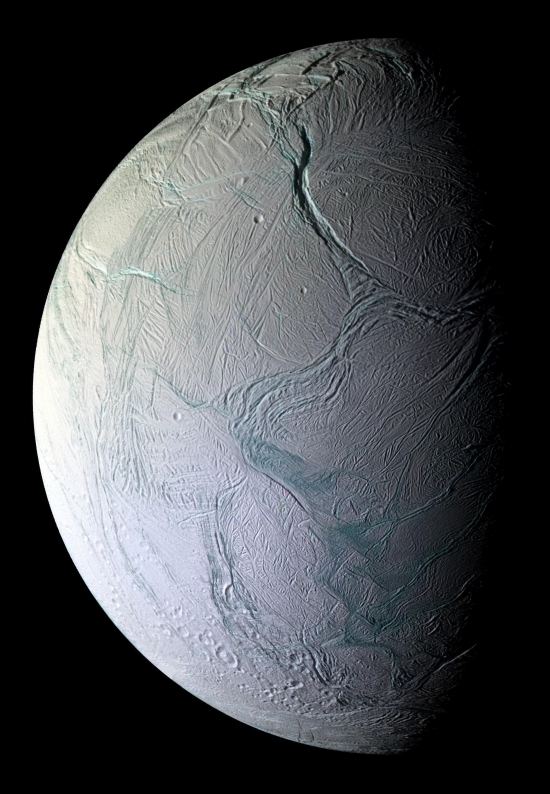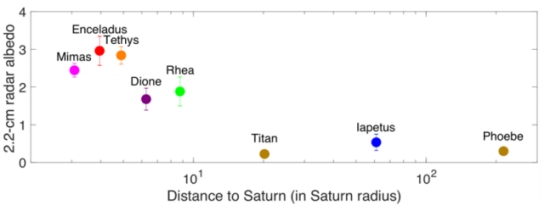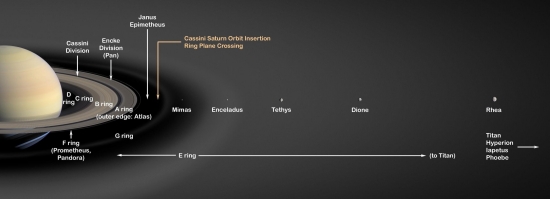In his wonderful account of the rocket that never was (Project Orion: The True Story of the Atomic Spaceship, 2002), George Dyson discusses his father’s thoughts on taking the craft to the moons of Saturn. Freeman Dyson and other Orion colleagues wanted to land on a moon to pick up propellant, but thought the moons of Jupiter were trickier than Saturn’s because of the depth of the Jovian gravity well. Anyway, Enceladus was a kind of beacon, and it was there Dyson fixed his attention. George Dyson quotes Freeman on the matter:
“We knew very little about the satellites in those days. Enceladus looked particularly good. It was known to have a density of .618, so it clearly had to be made of ice plus hydrocarbons, really light things; which were what you need both for biology and for propellant, so you could imagine growing your vegetables there. Five-one-thousandths g on Enceladus is a very gentle gravity, just enough so that you won’t jump off.”
As George noted, Enceladus was a long way from La Jolla, CA (where General Atomic had moved in 1958 to a 300-acre facility above the beaches near Torrey Pines), some 9 astronomical units, but the views would be spectacular. Imagine standing on Enceladus, where Saturn would appear vastly larger than Earth’s moon appears to us. Planet and rings would fill the sky, “changing phase from hour to hour, illuminated by the pale light of a distant sun.”

Image: Mosaic of the surface of Enceladus captured by Cassini on 9th October 2008 from an altitude of 25 kilometres. Credit: NASA/JPL/Space Science Institute.
We now know just how prescient Freeman Dyson was about the virtues of Enceladus, armed with Cassini data about geysers and an internal ocean. I always keep an eye on further insights from Cassini about this intriguing moon, and notice that at the EPSC-DPS joint meeting in Geneva this week, a team of researchers under Alice Le Gall (LATMOS-UVSQ, Paris) has analyzed some 60 radar observations of Saturn’s inner moons taken by Cassini. The result: Previous reports from these data underestimated their radar brightness by a factor of two.
All of Saturn’s inner moons show high radar reflectivity, with Enceladus itself being twice as bright as Europa, which is the brightest of Jupiter’s satellites. Significant variation turns up among the moons of Saturn, with Enceladus having the highest radar albedo, Titan the lowest.

Image: This is Figure 1 from the precis of Dr. Le Gall’s presentation. Caption: Averaged 2.2-cm disk-integrated radar albedos of Saturn’s major satellites. The error bars show the dispersion of the dataset for each satellite. Credit: Alice Le Gall.
What we’re witnessing among these inner moons is a fascinating interplay of material being pumped from the internal ocean of Enceladus into nearby space, affecting Tethys and Mimas. These three moons also interact with Saturn’s E-ring, which delivers water ice to their surfaces. The dazzling reflectivity that attracted the Orion team is largely the result of fresh water-ice particles from Enceladus, which acts as what Dr. Le Gall calls a ‘snow-cannon’ to coat all three surfaces. In other words, it snows on these worlds, in the sense that the particles fall back onto Enceladus and precipitate onto the surfaces of the other moons as well. Says Le Gall:
“The super-bright radar signals that we observe require a snow cover that is at least a few tens of centimetres thick. However, the composition alone cannot explain the extremely bright levels recorded. Radar waves can penetrate transparent ice down to [a] few meters and therefore have more opportunities to bounce off buried structures. The sub-surfaces of Saturn’s inner moons must contain highly efficient retro-reflectors that preferentially backscatter radar waves towards their source.”
Just what these ‘structures’ are is not known, though radar observations of Enceladus have shown subsurface features including pinnacles and ice blocks, along with fractured terrain. Le Gall’s team has developed models to test what specific shapes can act as effective reflectors, also testing whether enhanced reflection is a matter of random scattering events. This is a work in progress:
“So far, we don’t have a definitive answer,” adds Le Gall. “However, understanding these radar measurements better will give us a clearer picture of the evolution of these moons and their interaction with Saturn’s unique ring environment. This work could also be useful for future missions to land on the moons.”

The presentation is Le Gall et al., “Saturn’s inner moons: why are they so radar-bright?” in EPSC Abstracts Vol. 13, EPSC-DPS 2019-454-2, 2019 EPSC-DPS Joint Meeting 2019 (abstract).



Small correction: it’s Alice le Gall not le Gail. Regards, J
Thanks for catching that! I’ve corrected the text.
The Project Orion spacecraft made for a good talking point, but it seems like it must always have been deeply implausible. The proposal is to load a decent sized nuclear war’s worth of weapons onto a spaceship, then see whether the untested technology of a pusher plate exposed to thousands of nuclear explosions remains stable all the way to another star system. The cost would be variable and uncertain, perhaps being a bit less than a trillion 1968 dollars.
Surely if we were willing to invest a fraction of this expenditure into basic research (perhaps a mere $500 billion 2020 dollars for NASA and private space contractors, less than the cost of a Middle Eastern war!), we should be able to construct equipment to mass produce antiprotons and antielectrons, and riddle out some way to safely store away multiple grams of cryogenic solid antihydrogen. (For more than 1000 seconds, that is) Once safely stored, it might be cleanly and gradually tapped to power a thermodynamically efficient, stable, and powerful thruster. Around this we could build a very small ship with automated instruments that could make the entire trip under conditions of continuous multi-g acceleration and deceleration. (This would have been harder in 1968, but not impossible even then) The success of the project would scarcely be assured, but the same was true of Orion, and there would be less excitement from a CATO. Whatever happened, at least most of this expenditure would be to create a legacy of research, even if much of that knowledge would be prone to misuse.
The first requirement would be to eliminate the
parasitic feeders: government bureaucratic kingdoms and sub-bureaucracies, lobbyists and legislators: local, state and federal; contractors, subcontractors and their bureaucracies and lobbyists, and the local constituencies of employees for them all. Otherwise the Elon Musks and Jeff Bezoses will continue to outbid them and leave them in the dust.
You will have better luck designing a working warp drive before getting rid of government bureaucracy.
When nuclear fusion and other proposals for interstellar propulsion stop being twenty years away for the last fifty years, then perhaps I will have a bot more confidence in their becoming a reality.
Meanwhile, Orion continues to be the main contender for an actual method of reaching the stars in a time period measuring less than millennia:
https://centauri-dreams.org/2016/09/16/project-orion-a-nuclear-bomb-and-rocket-all-in-one/
The way planet Earth is going, there won’t be much of a civilization left when this hypothetical anti-matter powered craft returns from another star system.
All of our hopes for a solar system-wide economy and eventual star-faring are predicated on continued economic growth to make these viable. However, it is now abundantly clear that current energy generation and resource utilization are reaching [more probably have exceeded] their limits in terms of of ecosystem support. We need to drastically and rapidly change what we are doing to ensure that we have a future, let alone a richer one. It may be hard to focus on starships while much of humanity, let alone the rest of the fauna and flora are dying.
As Robin intimates, private funding may have to be the driver, at least until the wealth and income of the insanely wealthy is taxed to depletion.
The far more affordable approach of sending tiny craft to exoplanets (and bodies in our own system) seems like a far more sensible way of sending intelligence to explore our universe. We really need to accept that intelligence does not need to be accompanied by 100+ kg of meat with all the associated life support, spacecraft mass, and propulsion energy needed to project that intelligence to distant worlds. Human-level AGI running on a few [milli]watts of power is magic pixie dust today, but perhaps not in less than a century from now. More importantly, we can send our robot explorers out there without needing a vastly larger economy to do so. Consider how expensive the Discovery from “2001: A Space Odyssey” would be with its 5 person crew would be today, just to reach Saturn’s moons. How much less expensive would it be to send a robotic craft to do the same task. The irony of the movie today is that HAL 9000 is still a more capable AI than anything we have and supposedly could do the crew’s tasks alone in case of a loss of that crew. Why send that crew at all?
Well, if people don’t come up with antimatter tech for good reasons, they surely would love to develop it for bad ones. After all, roughly 25 milligrams of antimatter gets you a kiloton explosion – the perfect companion for one of those robotic midges the computer science people spend their time creating. Sent into bunkers or lingering quietly in the nasal passages of visiting dignitaries or their family members, these could have quite the impact on international relations. Still, if the technology exists, those authorized to use it are likely to play with space probes, and need little else to do so.
I would think that if you could mass produce some variant of scanning probe microscope on a chip that can influence antimatter according to charge distribution on the atomic scale, you might manipulate small masses of antimatter at a small distance away in vacuum. Though designing the system to stop a movement produced by a single background annihilation before it led to a collision would be no easy task! Past that you might want to make atomically perfect crystals of solid antihydrogen … perhaps you need to mass produce a Tetris-playing robot on the atomic scale armed with an MRI-on-a-chip. Well, alright, it does sound pretty unlikely, but it is surely more feasible than anyone forking over a trillion dollars to launch a spaceship with a thousand nukes on board.
Well said Alex. The future is now as far as climate change is concerned. A conservative estimate gives us about 10 years before climate change activates various positive feedback loops that cannot be stopped. Think about that please. Ten years. And we have various governments working actively to ensure that nothing gets done. There are no positive outcomes available if we continue to produce huge amounts of greenhouse gases to power our civilization. Many organizations and governments (including the major oil companies) know this to be a fact. The oil companies will be sued for knowingly destroying our environment just as tobacco companies were successfully sued for knowingly selling cancer causing products. The difference might be that it may be too late to recover as far as the oil companies go. It would be interesting to see the effect of putting senior oil executives on trial for their crimes (I think Rex Tillerson might be a good person to start with). But it seems powerful people are no longer held accountable. And what will the price be for that error in judgement for future generations?
Is there any comparison to radar reflection albedo of icy surfaces on Earth? We have plenty of examples from snowy landscapes to glaciers in various landscapes. Are these in any way informative?
You mention sending minature probes instead of people.
Carl Sagan was talking about movies about mad scientists wanting to miniaturize people.
In 2017 there was a movie called Downsizing, about miniature people. It got mixed reviews.
Wikipedia has an article, List of films featuring miniature people.
James Blish had a story, “Surface Tension”, about genetically engineered microscopic humans.
I wonder if some Hollywood exec was told about Blish’s story and it got transmogrified into “Downsizing?” Probably not.
New Kinds of Organic Compounds Found in Plumes Bursting From Saturn’s Moon Enceladus!
New kinds of organic compounds, the ingredients of amino acids, have been detected in the plumes bursting from Saturn’s moon Enceladus. The findings are the result of the ongoing deep dive into data from NASA’s Cassini mission.
https://scitechdaily.com/new-kinds-of-organic-compounds-found-in-plumes-bursting-from-saturns-moon-enceladus/
Enceladus may not justbe painting the Saturnian inner moons with just fresh bright ice, but with NO compounds that are precursers to amino acids. Check out today’s http://www.portaltotheuniverse Blogs section for details.
Sorry. It is actually in the Featured News section.
This one:
https://www.jpl.nasa.gov/news/news.php?release=2019-197&rn=news.xml&rst=7510